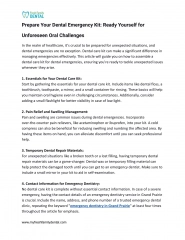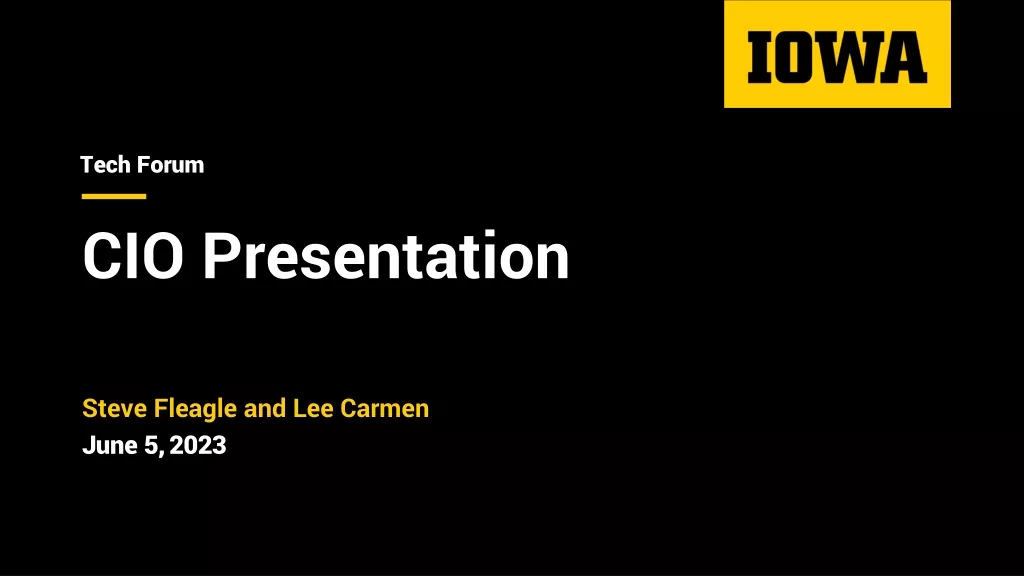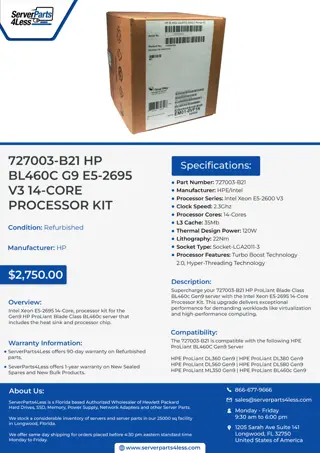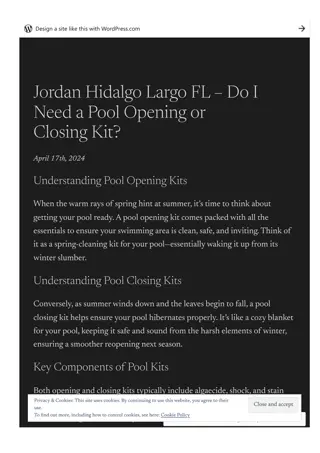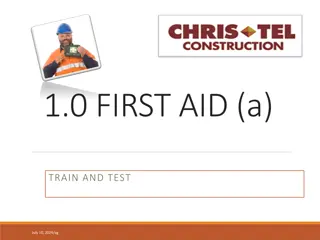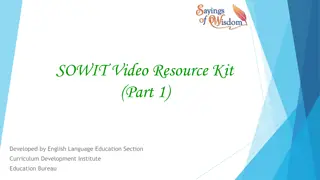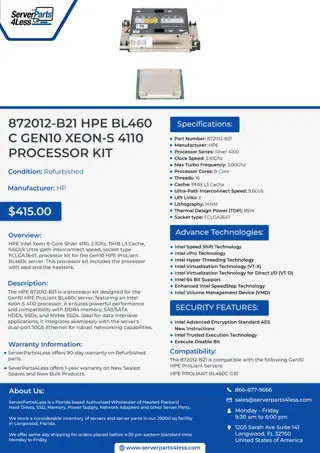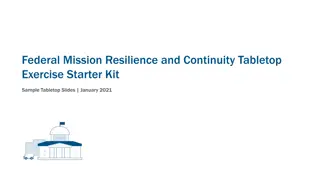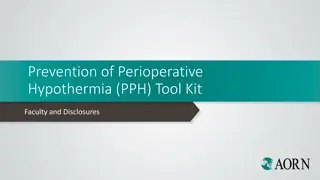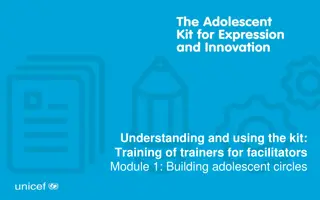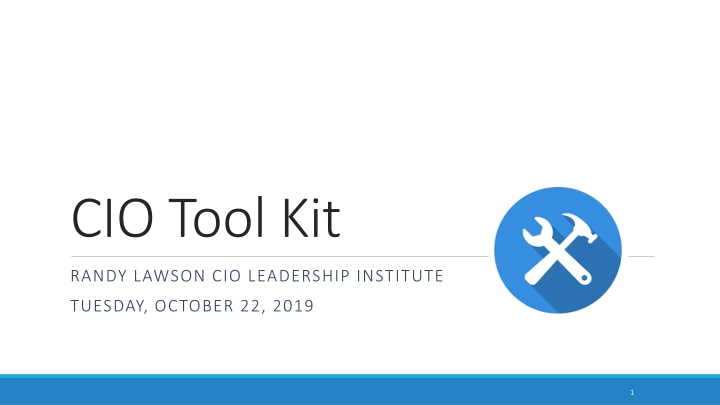
CIO Tool Kit
This content discusses tools, strategies, and guidelines for CIOs to effectively navigate regulations, remain compliant, promote efficiency, and think creatively within constraints. It emphasizes the importance of understanding regulations such as Title 5 and Ed Code to avoid legal violations, inefficiencies, and promote student-centered planning.
Download Presentation

Please find below an Image/Link to download the presentation.
The content on the website is provided AS IS for your information and personal use only. It may not be sold, licensed, or shared on other websites without obtaining consent from the author. If you encounter any issues during the download, it is possible that the publisher has removed the file from their server.
You are allowed to download the files provided on this website for personal or commercial use, subject to the condition that they are used lawfully. All files are the property of their respective owners.
The content on the website is provided AS IS for your information and personal use only. It may not be sold, licensed, or shared on other websites without obtaining consent from the author.
E N D
Presentation Transcript
CIO Tool Kit RANDY LAWSON CIO LEADERSHIP INSTITUTE TUESDAY, OCTOBER 22, 2019 1
Sheri Berger Pierce College (West Central Region - 6) Carol Farrar Riverside City College (Desert Region - 9) Presenters Brian Sanders Columbia College (Treasurer, East Central Region - 5) 2
1. The Administrators Box 2. Top Drawer Tools 3. Attendance Accounting & Scheduling 4. Efficiency/Productivity & The Handy- Dandy Class Size Balancing Machine 5. Finding & Using Title 5 & Ed Code 6. MIS Coding, The Data Element Dictionary, & the SCFF Session Overview 3
Working Insidethe AdministratorsBox Guidelines & Regulations: Title 5, Ed Code, Student Attendance Accounting Manual Program and Course Approval Handbook College Program or Activity Budget Resource Allocation, Efficiency, and Prioritization Minimum Qualifications Credit or Noncredit Faculty Contract & College Organizational Chart Loads Stacked Loads Disciplines Cross-Listing 4
Our Task: Know the constraints Know where to find the fine print Workcreatively within the box! Remain compliant Promote efficiency Promote students-first planning Thinking Outside the Box Guidelines & Regulations: Title 5, Ed Code, Student Attendance Accounting Manual Program and Course Approval Handbook College Program or Activity Consequences of being outside the box: Regulatory or legal violations Unqualified instructors repay, lost credits SAAM repay, fraud Contract grievance, past practice, lawsuits, PERB Budgets & Efficiency Budget Resource Allocation, Efficiency, and Prioritization Minimum Qualifications Credit or Noncredit Faculty Contract & College Organizational Chart Loads Stacked Loads Disciplines Cross-Listing Noncompliant, illegal, inefficient, ineffective Unemployment 5
Moving the Boundaries of the Box As CIOs, we have the Positional status Expertise Experience Voice at the table Guidelines & Regulations: Title 5, Ed Code, Student Attendance Accounting Manual Program and Course Approval Handbook To promote and achieve change and improvement Identify areas for change Educate about consequences of current situation Develop proposed solutions Work with other constituent groups to secure support (e.g. ASCCC, CBOs, CEOs) Shepherd new ideas to fruition College Program or Activity Budget Resource Allocation, Efficiency, and Prioritization Minimum Qualifications Credit or Noncredit Faculty Contract & College Organizational Chart Loads Stacked Loads Disciplines Cross-Listing 6
CIOs as Change Agents ASCERTAIN THE LOCUS OF CONTROL EFFECTIVE CIO CHANGE AGENTS Local practice College or District Convincingly explain the Why Local policy College or District Act collectively as the CCCCIO Accreditation expectations Maintain sled dog determination Accreditation requirements Remain patient and trust the process State guidelines for practice State regulations State laws Federal regulations and/or laws 7
Administrators Top Drawer Tools 1. Student Attendance Accounting Manual website under construction 2. Program and Course Approval Handbook latest version 3. Minimum Qualifications for Faculty and Administrators in California Community Colleges latest version 4. Westlaw s California Code of Regulations Title 5 5. California Education Code 6. Chancellor s Office Curriculum and Instruction Unit 7. The Course Outline of Record: A Curriculum Reference Guide Revisited ASCCC, Spring 2017 8. Data Element Dictionary Currently under reconstruction 8
Attendance Accounting & Scheduling FUNDAMENTALS, EXAMPLES, CASE STUDIES, AND CALCULATIONS FOR YOUR OWN DISTRICT 9
Fulltime Equivalent Student Factors in FTES calculation Clock Hour vs Class Hour Passing Time and Break Time Partial Class Hour Multiple Hour Class Attendance Accounting Methods Weekly Student Contact Hour Daily Student Contact Hour Actual Hours of Attendance (positive attendance) Independent Study and Work Experience Noncredit Distance Education Section Overview 10
Full-time equivalent student (FTES) 1 FTES = 1 student 15 hours per week 2 semesters of 17.5 weeks = 525 weekly student contact hours (WSCH) 11
Factors in FTES calculation Clock hour vs Class Hour Clock Hour A 60-minute time frame Class Hour A period of not less than 50 minutes of scheduled instruction There can be only one class hour in each clock hour, except as provided for multiple hour classes A class hour is commonly called a student contact hour 12
Factors in FTES calculation Passing Time and Break Time Each clock hour is composed of one class hour segment and a segment referred to as passing time or break time No additional attendance may be claimed for the 10-minute segment, except for multiple hour classes The 10-minute break time permitted in each clock hour may not be accumulated during a multi-hour block scheduled class to be taken all at once and be counted for FTES purposes. 13
Factors in FTES calculation Partial Class Hour A "partial class hour" is that fractional part of a class hour in a class scheduled for more than one clock hour 14
Factors in FTES calculation Multiple Hour Class Any period of instruction scheduled continuously for more than one clock hour Each 50 minutes exclusive of breaks is a class/contact hour A fractional part of a class hour beyond the last full clock hour is counted from the 51st minute of the last full clock hour No class break is allowed in the last full clock hour or the partial class hour The divisor for this fractional part of a class hour is 50. 15
Factors in FTES calculation Multiple Hour Class Calculation example 7:00 pm to 10:05 pm Partial Class Hour 9:51 10:05 = 15 min 15/50 = 0.3 Total Contact Hour = 3.3 Includes 20 min break time 16
Factors in FTES calculation Calculate Contact Hours Class meets from 0800 to 0850 0800 to 0900 0800 to 0905 0800 to 0950 0800 to 1000 0800 to 1005 0800 to 1030 0800 to 1225 Contact Hours 1.0 1.0 1.3 2.0 2.0 2.3 2.8 4.7 Breaks None None None One 10-min One 10-min One 10-min One 10-min Three 10-min 17
Hrs Min # Bk Bk Min 0 0 0 0 0 0 0 0 0 0 10 10 10 10 10 10 10 10 10 10 10 10 20 20 20 Hrs Min # Bk Bk Min 20 20 20 20 20 20 20 20 20 30 30 30 30 30 30 30 30 30 30 30 30 40 40 40 1.0 1.0 1.0 1.3 1.4 1.5 1.6 1.7 1.8 1.9 1.9 1.9 2.0 2.0 2.0 2.3 2.4 2.5 2.6 2.7 2.8 2.9 2.9 2.9 3.0 50 55 60 65 70 75 80 85 90 95 100 105 110 115 120 125 130 135 140 145 150 155 160 165 170 0 0 0 0 0 0 0 0 0 0 1 1 1 1 1 1 1 1 1 1 1 1 2 2 2 3.0 3.0 3.3 3.4 3.5 3.6 3.7 3.8 3.9 3.9 3.9 4.0 4.0 4.0 4.3 4.4 4.5 4.6 4.7 4.8 4.9 4.9 4.9 5.0 etc. 175 180 185 190 195 200 205 210 215 220 225 230 235 240 245 250 255 260 265 270 275 280 285 290 2 2 2 2 2 2 2 2 2 3 3 3 3 3 3 3 3 3 3 3 3 4 4 4 Key to Hours Calculations 50 min + 10-min break + 50 min + 10-min break + final session up to 95 minutes without a break Example: 190 min = 3.4 apportionment hours is calculated this way: 50 min class + 10 min break = 1st 60-min hr = 1.0 appt hr 50 min class + 10 min break = 2nd 60-min hr = 1.0 appt hr Final 70-min session with no breaks = 1.4 appt hrs Total = 3.4 appt hrs 18
Interactive Moment Determine contact hours. Class meets 1. Tuesdays from 6:00 pm to 8:50 pm 2. Tuesdays from 6:00 pm to 9:00 pm 3. Tuesdays from 6:00 pm to 9:05 pm 4. Monday & Wednesday from 8:00 am to 10:30 am 5. Monday from 12:00-1:05 pm for lecture and Wednesday from 3:00-6:05 pm for lab 6. Monday & Wednesday from 9:00 to 10:00 am for lecture then from 10:00 am 1:00 pm for lab. 7. Thursday morning from 8:00-8:30 am for lecture then from 8:30 am to 2:30 pm for lab. 19
Attendance Accounting Methods Weekly Student Contact Hour Daily Student Contact Hour Actual Hours of Attendance (positive attendance) Independent Study and Work Experience Education (includes credit or noncredit Distance Education courses) Noncredit Distance Education 20
Attendance Accounting Methods Weekly Student Contact Hour Primary terms only (fall/spring) Class is coterminous with primary term Meets regularly every week Same number of hours each week including TBA hours No deduction for holidays (i.e. holidays are forgiven ) 21
Attendance Accounting Methods Census Week - WSCH The week nearest to 20% of the number of weeks in the term Census date is on Monday of census week Except if Monday is a holiday, then census date is the following day 22
Attendance Accounting Methods Term Length Multiplier (TLM) TLM is the number of weeks in a primary terms with at least three days of instruction The TLM for each college is set by the Chancellor s Office based on the college s academic calendar Maximum TLM: 17.5 for semesters TLMs for 2019-2020 (CCCCO.edu: search for Student Attendance Accounting Manual) Interactive moment: Find your TLM! 23
Attendance Accounting Methods FTES Calculation for WSCH Multiply Census Week WSCH by the TLM and divide of 525 FTES = (CWSCH TLM) 525 Census Week WSCH: multiply the number of students enrolled by the weekly contact hours Ex: 40 students in a class meeting 3 hours/week and TLM=17.5 FTES = (40 3 17.5) 525 = 4.00 24
Interactive Moment Determine contact hours Weekly Apportionment 1. Class meets Tuesdays from 6:00 pm to 8:50 pm (use 17.5 weeks per term). Determine the total term contact hours. 2. Class meets Tuesdays from 6:00 pm to 9:05 pm (use 16.4 weeks per term). Determine the total term contact hours. 3. Class meets Monday & Wednesday from 8:00 am to 10:30 am (use 16.8 weeks per term). Determine the total term contact hours. 4. Class needs 52.5 contact hours with two meetings per week (use 17.5 weeks per term). How long is each session? What is your percent of target hours? (Scheduled hrs / COR hrs) 5. Class needs 90 contact hours with two meetings per week (use 16.8 weeks per term) How long is each session? What is your percent of target hours? (Scheduled hrs / COR hrs) 6. Class needs 72 contact hours with four meetings per week (use 16.4 weeks per term) How long is each session? What is your percent of target hours? (Scheduled hrs / COR hrs) 25
Working backwards from Course Outline of Record Determine Course Hours to Schedule 1. Get the expected hours on the Course Outline of Record 2. Divide by the TLM to get hours per week 3. Divide by the number of meetings per week to get hours per session 4. Round UP to the nearest tenth of an hour 5. Watch out for gray areas! 6. Check your math. Hrs/session x # sessions/wk x TLM. How many hours did you end up with? 1. 2. 3. Good practice: Exceed the hours on the COR by the least amount possible. Good practice: 100-105% of COR hours You can schedule below the target but must meet or exceed minimums in Title 5 55002.5 1. 2. 3. 16 hours of lecture + 32 hours outside class per unit 32 hours of activity + 16 hours outside class per unit 48 hours of laboratory unit 26
Attendance Accounting Methods Daily Student Contact Hour (DSCH) Class meets five or more days Meets regularly: the same number of hour on each scheduled day, including any TBA hours NOT coterminous with primary term Always used in summer, winter, and partial terms (e.g. first 8 weeks, last 8 weeks, late-start 12-week classes) No hours counted for holidays (i.e. holidays not forgiven ) Option A: College loses those contact hours. Beware T5 min hrs! Option B: Extend class hours to cover missing holidays. 27
Attendance Accounting Methods Census Day - DSCH The day of the class meeting that is nearest 20% of the number of days the course scheduled to meet When census day falls on the first day the class meets, census is taken on the second day 28
Attendance Accounting Methods Course Length Multiplier (CLM) CLM is the number of days the course is scheduled to meet That is, the number of class meetings 29
Attendance Accounting Methods FTES Calculation for DSCH Multiply Census Day DSCH by the CLM and divide by 525 FTES = (CDSCH CLM) 525 Census Week DSCH: multiply the number of students enrolled by the daily contact hours Example: 40 students in a class meeting 2 hours/day and TLM=20 FTES = (40 2 20) 525 = 3.05 30
Interactive Moment Determine contact hours Daily Apportionment 1. Class meets M-Th for 5 wks minus 1 holiday from 8:00 am to 10:30 am. Find term hrs. 2. Class meets 8 Monday nights from 6:00 pm to 9:35 pm. Find term hrs. Trick question! 3. Monday from 12:00-1:05 pm for lecture and Wednesday from 3:00-6:05 pm for lab for 6 weeks. No holidays. 4. Class needs 52.5 contact hours with two meetings per week over 6 weeks. No holidays. How long is each session? What is your percent of target hours? 5. Class needs 90 contact hours with four meetings per week for 10 weeks with one holiday. How long is each session? What is your percent of target hours? 6. Class needs 36 hours of lecture and 108 hours of lab with 19 class meeting sessions, when holidays are removed. How do you schedule it? 31
Attendance Accounting Methods Actual Hours of Attendance (Positive Attendance) Based on actual count of enrolled students present at each class meeting Courses meeting fewer than five days Courses irregularly scheduled for the number of days per week (full term) or number of hours on scheduled days (short term) All face-to-face noncredit courses Open entry/open exit courses Calculation: divide the total hours of actual attendance by 525 32
Attendance Accounting Methods Independent Study and Work Experience Education One student contact hour shall be counted for each unit of credit for which the student is enrolled as of the census date or day Calculation: Multiply the number of students enrolled as of the census date by the weekly contact hours and by the TLM, then divide by 525 FTES = (# of students WCH TLM) 525 33
Interactive Moment Determine contact hours Alternative Apportionment 1. 3-unit lecture class meets online in your district for 3.5 hours per week. How many contact hours are you paid for? 2. 3-unit class with 2 units of lecture online (2.2 hours per week online) and 1 unit of lab meeting face-to-face (3.3 hours per week) for 16.4 weeks. 3. Can you do 2.2 hours per week online? 4. What if you have labs every other Saturday with F2F lectures? 5. What if you have labs every other Saturday with online lectures? 34
Attendance Accounting Methods Noncredit Distance Education Courses First, a weekly student contact hour (WSCH) factor is calculated That factor is used to calculate the student workload as of each of two census dates First census: one-fifth in the length of each course Second census: three-fifths point in the length of each course Enrollment is counted as the average of these two. 35
Attendance Accounting Methods Deriving the WSCH Factor for noncredit distance education (1) Calculate the total number of hours of coursework required for a class: The total number of hours of instruction to be received by students in the class. The number of hours expected for any outside-of-class work (as noted in the approved class outline), plus Any instructor contact as defined by Title 5 Section 55376(b). (2) Divide the sum of the hours as determined in (1) by 54 (a measure equating to a unit of credit similar to that used in credit distance education). (3) The resultant figure is the WSCH factor 36
Attendance Accounting Methods Calculating FTES for Noncredit Distance Education Determine first census attendance at 1/5 point in term First census student contact hours is: WSCH Factor # of students at first census 17.5 = Student Contact Hours Determine second census attendance at 3/5 point in term Second census student contact hours is: WSCH Factor # of students at second census 17.5 = Student Contact Hours FTES is average of first and second census Student Contact Hours, divided by 525 Note: The factor of 17.5 is to be used no matter what length the course. This is not a term length multiplier. 37
Attendance Accounting Methods FTES Calculation for Noncredit Distance Education - example 6-week class: 10 hrs/week of instruction & 5 hrs/week of HW WSCH Factor = (15 6) 54 = 90 54 = 1.667 First Census: (at 1/5 point) 24 students actively enrolled 1.667 (WSCH Factor) 24 students x 17.5 = 700.14 Student Contact Hours Second Census: (at 3/5 point) 20 students actively enrolled 1.667 (WSCH Factor) x 20 students x 17.5 = 583.45 Student Contact Hours The average of the first and second census Student Contact Hours, divided by 525 equals the FTES: FTES = (700.14+583.45) 2 525 = 1.22 38
Interactive Moment Intricacies of Non-Credit Distance Education Apportionment 1. What do the 54 and 17.5 in this calculation trace back to? 2. Do the two factors relate ? 3. Is there homework in noncredit? 4. What about office hours ? 5. Do you earn more or fewer hours with this average value? 6. Is this a prevalent methodology? 39
Efficiency/Productivity and the Handy-Dandy Class Size Balancing Machine AN OBJECT LESSON IN THE CUMULATIVE EFFECT OF 1000 SMALL ACTIONS 40
The Handy-Dandy Class Size Balancing Machine An object lesson and discussion 41
Finding and Using Title 5 and Education Code NAVIGATION, HOW-TO, AND CASE STUDIES 42
We now flip you over to last years awesome Title 5 and Education Code Presentation by Leandra Martin and Irene Malmgren! 43
Education Code Education Code & & Title 5 Title 5 DR. LEANDRA MARTIN: VICE PRESIDENT OF MISSION COLLEGE DR. IRENE MALMGREN: EMERITUS VICE PRESIDENT, INSTRUCTION, MT SAC 44
California Educational Code California Educational Code http://leginfo.legislature.ca.gov/ Laws (started as Bills) passed by the California Legislature Can only be changed by legislation or budget action Education Code is the highest authority (informs Title 5) 45
California Education Code o Title 3 Postsecondary Education Division 7 Community Colleges Part 43 The California Community College Part 44 Board of Governors Part 45 Districts and Governing Boards Part 46 District Reorganization of Formulation Part 47 Students Part 48 Community Colleges, Education Programs Part 49 Community Colleges, Educational Facilities Part 50 Finance Part 51 Employees Part 52 Career Technical Educations Pathways Program (repealed) Part 52.5 California Community Colleges Economic and Workforce Development Program Part 53 Basic Skills Partnership Pilot Program Part 54 Community Colleges Basic Skills and Student Outcomes Transformation Program Part 54.3 Student Success for Basic Skills Program Part 54.5 Strong Workforce Program Part 54.7 California College Promise Innovation Grant Program 46
California Education Code o Title 3 Postsecondary Education Division 7 Community Colleges Part 47 Students o Chapter 1 General Provisions oChapter 1.5 Student Records o Chapter 2 Fees o Chapter 3 Student Health Services and Supervisions 47
California Education Code o Title 3 Postsecondary Education Division 7 Community Colleges Part 47 Chapter 1.5 Article 1 Legislative Intent Article 2 Definition Article 3 General Provisions Article 4 Rights of Students Article 5 Privacy of Student Records 48
California Education Code o Title 3 Postsecondary Education Division 7 Community Colleges Part 47 Chapter 1.5 Article 3 o 76220 Regulations: establishment, maintenance, and destruction o 76221 Notifying students of their rights under this chapter o 76222 Log of persons and organizations requesting or receiving information o 76223 Reasonable charge for transcripts; exceptions o 76224 Grades: finalization: physical education class o 76225 Transfer of records: notice of rights regulation 49
76224 Grades: Finalization: Physical Education Class o (a)When grades are given for any course of instruction taught at a community college district, the grade given to each student shall be the grade determined by the instructor of the course and the determination of the grade by the instructor, in the absence of mistake, fraud, bad faith, or incompetency, shall be final. o (b) No grade of a student participating in a physical education class, however, may be adversely affected due to the fact that the student does not wear standardized physical education apparel where the failure to wear such apparel arises from circumstances beyond the control of the student. 50

